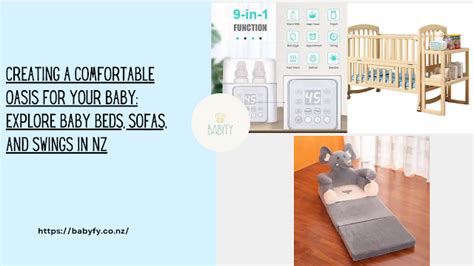Creating a serene and tranquil environment for your precious bundle of joy is an art that every parent aspires to master. A baby's sleeping area is not just a mere piece of furniture; it is a haven where dreams are forged and a sanctuary where comfort and safety intertwine.
Embarking on the journey of crafting a crib fit for your little prince or princess involves careful consideration of various factors. From selecting the right materials to ensuring optimal functionality, every detail must be meticulously thought out to provide an oasis of serenity for your baby's slumber.
With an array of options available in the market, it can be overwhelming to navigate through the myriad of choices. From minimalist designs to whimsical motifs, the search for the perfect crib can be an exciting yet daunting task. However, fear not, for we are here to guide you on this exhilarating quest. Discover the secrets to creating a sleep space that is not only visually appealing but also promotes deep and rejuvenating rest for your little one.
Creating a Safe and Cozy Haven for Your Little One

When it comes to setting up a soothing and secure environment for your precious bundle of joy, it is essential to consider various factors to ensure their comfort and safety. Taking the time to carefully design the perfect space for your baby will not only contribute to their overall well-being but also provide you with peace of mind.
1. Prioritize Safety First To create a safe and secure environment for your baby, it is crucial to pay attention to every detail. Ensure that the crib meets the safety standards and guidelines set by reputable organizations. This includes verifying the slats' spacing, the sturdiness of the crib structure, and the absence of loose or sharp edges. | 2. Optimize Sleep Quality A comfortable crib promotes better sleep for your baby. Invest in a high-quality mattress that provides adequate support and doesn't sag. Additionally, dress the crib with soft and breathable bedding such as fitted sheets, blankets, and cozy sleep sacks to keep your little one snug and warm throughout the night. |
3. Establish a Calming Atmosphere Creating a peaceful ambiance in your baby's sleep space can contribute to a serene and restful environment. Consider using dimmable lights or blackout curtains to regulate the level of natural light during naptime. Softly playing calming music or using white noise machines can also help drown out external noises and lull your baby into a peaceful slumber. | 4. Promote a Healthy Air Quality Air quality plays a significant role in your baby's overall health and sleep. Ensure proper ventilation in the nursery by keeping windows open when weather permits or using air purifiers or humidifiers to maintain optimal humidity levels. Regularly clean and dust the room to minimize allergens, and avoid using harsh chemical cleaners that may irritate your baby's sensitive respiratory system. |
5. Create a Practical Layout A well-organized nursery layout can make caregiving tasks more efficient and convenient. Consider placing essential items such as diapers, wipes, and a changing station within arm's reach. Designate specific areas for feeding and playtime, ensuring that the space is both functional and visually pleasing. | 6. Personalize with Love Adding your personal touch to your baby's sleep space can make it feel even more special and welcoming. Hang wall decorations, such as framed artwork or decals, that reflect your unique style and create a warm and loving atmosphere for your little one. Incorporating soft plush toys and soothing mobiles can also add a touch of comfort and joy. |
By following these guidelines and customizing the sleep space to cater to your baby's needs, you can create an environment that promotes their safety, comfort, and peaceful rest. Remember, a safe and cozy haven not only helps your baby sleep better but also strengthens the loving bond between you and your little one.
Choosing the Right Crib: Factors to Consider
When it comes to providing a comfortable sleeping environment for your little one, selecting the perfect crib is essential. There are several important factors to consider to ensure that you choose the right crib that fits both your baby's needs and your personal preferences.
1. Safety: One of the primary considerations when choosing a crib is the safety features it offers. Look for cribs that meet safety standards and certifications, such as those set by the Consumer Product Safety Commission (CPSC) and the Juvenile Products Manufacturers Association (JPMA). Check for features like spaced slats, adjustable mattress heights, and sturdy construction to ensure a safe sleeping space for your baby. |
2. Size and Design: The size and design of the crib play a crucial role in the overall functionality and aesthetics of the nursery. Consider the dimensions of the crib to ensure it fits comfortably in the designated space. Additionally, think about the style and design that aligns with your taste and complements the overall decor of the room. |
3. Convertibility: Many cribs offer the option of convertibility, allowing them to be transformed into a toddler bed or even a full-size bed as your child grows. This feature can provide long-term value and save you from purchasing a new bed as your baby transitions into different stages. Consider whether you prefer a crib with this convertibility option. |
4. Mattress Support: The mattress support in a crib is another important factor to evaluate. Look for cribs with a sturdy and adjustable mattress base that offers proper support for your baby. The ability to change the height of the mattress as your child grows can prevent strain on your back and make it easier to lift your baby in and out of the crib. |
5. Durability and Quality: A durable and high-quality crib is a worthwhile investment that can last through multiple children. Consider the materials used in the construction, such as solid wood or metal, to ensure longevity. Carefully examine the craftsmanship, including the joints and finish, to ensure it meets your standards for quality. |
By considering these essential factors when choosing a crib, you can create a safe and comfortable sleeping environment for your baby that meets both their needs and your personal style preferences.
Creating a Serene Nursery: Blending Aesthetics and Practicality

When it comes to designing a nursery, striking the perfect balance between style and functionality is key. The nursery should be a peaceful haven that not only reflects your personal taste but also caters to the needs of your little one. In this section, we will explore various strategies and tips for creating a dreamy nursery that combines aesthetics and practicality harmoniously.
Choosing the Right Colors Color has a significant impact on the overall atmosphere of the nursery. Opting for soft, soothing shades such as pastels or neutral tones can create a tranquil environment conducive to restful sleep. Additionally, incorporating pops of vibrant colors through accents or wall art can add visual interest to the space without overwhelming it. |
Functional Furniture A nursery should be equipped with furniture that is not only visually appealing but also practical. Investing in pieces that can evolve with your child's needs, such as convertible cribs or changing tables with built-in storage, can help maximize the available space and ensure long-term functionality. Remember to consider safety features and ease of use when selecting furniture items. |
Embracing Natural Elements Incorporating natural elements into the nursery can create a soothing and organic ambiance. From using wood furniture to incorporating greenery or nature-inspired wall decals, these elements can add a touch of freshness and serenity to the space. |
Smart Storage Solutions Keeping the nursery clutter-free is essential for both aesthetics and functionality. Utilizing smart storage solutions, such as baskets, shelves, or labeled bins, can help organize baby essentials while maintaining a neat and tidy environment. Consider designing storage areas that are easily accessible and can adapt as your baby grows. |
Lighting and Ambiance Creating the right lighting and ambiance is crucial for a dreamy nursery. Adjustable lighting fixtures, such as dimmer switches or soft nightlights, can create a soothing atmosphere during nighttime routines. Additionally, incorporating blackout curtains or blinds can help regulate natural light and promote better sleep. |
By incorporating these design elements and considering the needs of both you and your baby, you can create a nursery that is not only visually stunning but also functional and conducive to a peaceful environment. Let your creativity and practicality intertwine to design a dreamy nursery that will be cherished for years to come.
Essential Accessories for the Ideal Nursery: From Linens to Musical Mobiles
Within the realm of creating the perfect sleeping environment for your little one, it is essential to consider the assortment of accessories that can enhance both the aesthetic appeal and functionality of their crib. From soft and cozy bedding to visually captivating mobiles, these carefully selected items can contribute to creating a nurturing space that not only promotes comfortable sleep but also fuels your baby's curiosity and development.
When it comes to choosing bedding for your baby's crib, opting for high-quality materials is of utmost importance. Soft and breathable linens crafted from organic cotton or bamboo fabric can provide a comfortable sleeping surface while ensuring optimal airflow for your baby's delicate skin. Additionally, selecting bedding sets that are hypoallergenic and free from harmful chemicals can help create a safe and healthy sleep environment for your little one.
Bedding sets often come with a variety of coordinated pieces to cover all your baby's needs. From fitted sheets that secure tightly around the crib mattress to reversible blankets that offer versatility in different temperatures, these linens ensure both comfort and style. Opt for designs that match the theme or color scheme of the nursery to create an aesthetically pleasing and harmonious space. |
In addition to linens, incorporating a musical mobile above the crib can provide stimulation for your baby's senses and promote a soothing environment. Musical mobiles typically feature soft melodies and gentle movements, capturing your baby's attention and helping them relax for naptime or bedtime. Choose mobiles with removable plush toys or hanging characters that can be later used as standalone toys for further engagement and development.
Furthermore, consider adding other crib accessories such as a canopy or drapes to create a cozy and enclosed space for your baby. Canopies not only add a touch of elegance to the nursery decor but also provide a sense of security and privacy, helping your little one feel safe and snug during sleep. Ensure proper installation and secure attachment to avoid any potential hazards.
Lastly, incorporating personal touches, such as embroidered pillows or stuffed animals, can add an extra layer of comfort and familiarity to your baby's crib. These items can provide a sense of companionship and reassurance, assisting your little one in feeling calm and settled in their sleep space.
In conclusion, selecting the right accessories for your baby's crib can greatly contribute to creating a nurturing and visually appealing sleep environment. From choosing high-quality bedding to incorporating stimulating mobiles and other personalized additions, these carefully curated items can transform your baby's crib into the perfect sanctuary for a restful and peaceful sleep.
Promoting Healthy Sleep Habits: Tips for a Restful Night's Sleep

Ensuring a peaceful and rejuvenating night's sleep is essential for everyone, regardless of age or stage of life. Developing healthy sleep habits not only benefits our physical wellbeing but also contributes to our mental and emotional health. In this section, we will explore some effective strategies and tips for promoting restful sleep that will help you wake up feeling refreshed and ready to take on the day with vigor.
Create a Consistent Bedtime Routine: Establishing a regular routine before bed can signal to your body that it's time to wind down and prepare for sleep. Consider incorporating relaxing activities such as reading a book, practicing gentle stretching, or enjoying a warm cup of herbal tea. Consistency is key, so try to maintain the same routine each night to optimize your body's natural sleep-wake cycle.
Optimize Your Sleep Environment: Pay attention to the conditions in your sleep environment to create a calm and soothing atmosphere. Keep your bedroom cool, dark, and quiet, as these factors can greatly enhance your ability to fall asleep and stay asleep throughout the night. Investing in a comfortable mattress, cozy bedding, and supportive pillows can also contribute to a more restful sleep.
Avoid Stimulants Before Bed: Certain substances can interfere with your ability to fall asleep and stay asleep. It's advisable to limit or avoid the consumption of caffeine, nicotine, and alcohol in the hours leading up to bedtime. These substances can disrupt your sleep patterns and make it more difficult to achieve the deep, restorative sleep your body needs.
Establish a Regular Sleep Schedule: Try to go to bed and wake up at the same time each day, even on weekends. By sticking to a consistent sleep schedule, you regulate your body's internal clock and promote a more consistent sleep pattern. This practice can help you feel more energized during the day and decrease the likelihood of experiencing sleep disturbances at night.
Practice Relaxation Techniques: Incorporating relaxation techniques into your evening routine can help calm your mind and prepare it for sleep. Deep breathing exercises, guided imagery, or meditation can all be effective methods for reducing stress and promoting a sense of inner tranquility. Consider allocating a few minutes each night to indulge in these mindful practices.
Avoid Electronic Devices Before Bed: The blue light emitted by electronic devices such as smartphones, tablets, and laptops can suppress the production of melatonin, a hormone that regulates sleep. To promote a restful night's sleep, it is advisable to turn off electronic devices at least an hour before bed. Instead, engage in activities that promote relaxation and prepare your body and mind for sleep.
Exercise Regularly: Engaging in regular physical activity can contribute to better sleep quality. However, it is advisable to complete your workout at least a few hours before bedtime to allow your body temperature to decrease and your heart rate to return to normal. Additionally, finding a balance between exercise intensity and timing is crucial, as vigorous workouts close to bedtime may energize your body and make it more difficult to fall asleep.
Avoid Napping Late in the Day: While brief power naps can be refreshing during the day, napping too late in the afternoon or evening can disrupt your sleep schedule. If you feel the need to nap, try to limit it to 20-30 minutes and aim to do so earlier in the day to avoid interfering with your nighttime rest.
Manage Stress Levels: High levels of stress can significantly impact your ability to achieve quality sleep. Managing stress through relaxation techniques, regular exercise, and seeking support from loved ones or professionals can contribute to overall better sleep quality. Consider incorporating stress management techniques into your daily routine to ensure a peaceful and restful night's sleep.
Incorporating these tips into your daily routine can help you establish healthy sleep habits and promote a restful night's sleep. By prioritizing your sleep and creating an environment conducive to relaxation, you can optimize your overall well-being and wake up each morning feeling rejuvenated and ready to conquer the day.
FAQ
What are some important factors to consider when creating the perfect sleep space for a baby?
When creating the perfect sleep space for a baby, it's important to consider factors such as crib safety, comfort, and a soothing environment. Make sure the crib meets all safety regulations, choose a comfortable mattress and bedding, and create a calming atmosphere with dim lighting and white noise if necessary.
How can I make my baby's crib safe?
To make your baby's crib safe, ensure that the mattress fits snugly and there are no gaps between the mattress and the crib's sides. Remove any toys, pillows, or blankets from the crib to reduce suffocation risks. Also, make sure the crib meets safety standards and has no loose or broken parts.
What are some tips for choosing the right crib mattress?
When choosing a crib mattress, opt for one that is firm and fits the crib perfectly, leaving no gaps. Look for a mattress made from non-toxic materials and waterproof coverings for easy cleaning. It's also recommended to purchase a new mattress rather than using a hand-me-down to ensure its quality and condition.
How can I create a soothing sleep environment for my baby?
Creating a soothing sleep environment for your baby involves keeping the room dark, using white noise or lullabies to drown out any disturbing noises, and maintaining a comfortable temperature. You can also consider using blackout curtains, a nightlight, or a baby monitor with a camera to ensure your baby's safety and comfort.
Are there any alternatives to traditional cribs?
Yes, there are alternatives to traditional cribs. Some parents opt for bassinets, co-sleepers, or bedside sleepers for the first few months, as they provide closer proximity to the baby. Additionally, convertible cribs that can convert into toddler beds or daybeds are becoming popular options to accommodate a child's growth.
What are some tips for creating the perfect sleep space for my baby?
Creating the perfect sleep space for your baby includes choosing a crib that meets safety standards, ensuring a comfortable mattress, using breathable bedding, maintaining a peaceful environment, and following a consistent sleep routine.




